Quick Look
Grade Level: 4 (3-5)
Time Required: 45 minutes
Expendable Cost/Group: US $0.00
Group Size: 3
Activity Dependency: None
Subject Areas: Geometry, Physical Science, Problem Solving, Science and Technology
NGSS Performance Expectations:

| 3-5-ETS1-1 |
| 3-5-ETS1-2 |
| 3-5-ETS1-3 |
Summary
Students are introduced to brainstorming and the design process in problem solving as it relates to engineering. They perform an activity to develop and understand problem solving with an emphasis on learning from history. Using only paper, straws, tape and paper clips, they create structures that can support the weight of at least one textbook. In their first attempts to build the structures, they build whatever comes to mind. For the second trial, they examine examples of successful buildings from history and try again.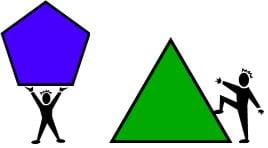
Engineering Connection
Engineers are presented with new challenges every day. At first, many of these problems may seem impossible to solve. To find a solution, engineers use problem-solving techniques and brainstorm as many creative ideas as possible. What seems impossible at first becomes possible through the use of teamwork, the engineering design process and learning from past successes and failures.
Learning Objectives
After this activity, students should be able to:
- Explain how engineers use history to guide their designs.
- Demonstrate problem-solving techniques such as brainstorming and the engineering design process.
- Explain that different shapes have different strengths.
- Realize that triangles are the strongest shape and recognize that they can be found in most structures.
Educational Standards
Each TeachEngineering lesson or activity is correlated to one or more K-12 science,
technology, engineering or math (STEM) educational standards.
All 100,000+ K-12 STEM standards covered in TeachEngineering are collected, maintained and packaged by the Achievement Standards Network (ASN),
a project of D2L (www.achievementstandards.org).
In the ASN, standards are hierarchically structured: first by source; e.g., by state; within source by type; e.g., science or mathematics;
within type by subtype, then by grade, etc.
Each TeachEngineering lesson or activity is correlated to one or more K-12 science, technology, engineering or math (STEM) educational standards.
All 100,000+ K-12 STEM standards covered in TeachEngineering are collected, maintained and packaged by the Achievement Standards Network (ASN), a project of D2L (www.achievementstandards.org).
In the ASN, standards are hierarchically structured: first by source; e.g., by state; within source by type; e.g., science or mathematics; within type by subtype, then by grade, etc.
NGSS: Next Generation Science Standards - Science
| NGSS Performance Expectation | ||
|---|---|---|
|
3-5-ETS1-1. Define a simple design problem reflecting a need or a want that includes specified criteria for success and constraints on materials, time, or cost. (Grades 3 - 5) Do you agree with this alignment? |
||
| Click to view other curriculum aligned to this Performance Expectation | ||
| This activity focuses on the following Three Dimensional Learning aspects of NGSS: | ||
| Science & Engineering Practices | Disciplinary Core Ideas | Crosscutting Concepts |
| Define a simple design problem that can be solved through the development of an object, tool, process, or system and includes several criteria for success and constraints on materials, time, or cost. Alignment agreement: | Possible solutions to a problem are limited by available materials and resources (constraints). The success of a designed solution is determined by considering the desired features of a solution (criteria). Different proposals for solutions can be compared on the basis of how well each one meets the specified criteria for success or how well each takes the constraints into account. Alignment agreement: | People's needs and wants change over time, as do their demands for new and improved technologies. Alignment agreement: |
| NGSS Performance Expectation | ||
|---|---|---|
|
3-5-ETS1-2. Generate and compare multiple possible solutions to a problem based on how well each is likely to meet the criteria and constraints of the problem. (Grades 3 - 5) Do you agree with this alignment? |
||
| Click to view other curriculum aligned to this Performance Expectation | ||
| This activity focuses on the following Three Dimensional Learning aspects of NGSS: | ||
| Science & Engineering Practices | Disciplinary Core Ideas | Crosscutting Concepts |
| Generate and compare multiple solutions to a problem based on how well they meet the criteria and constraints of the design problem. Alignment agreement: | Research on a problem should be carried out before beginning to design a solution. Testing a solution involves investigating how well it performs under a range of likely conditions. Alignment agreement: At whatever stage, communicating with peers about proposed solutions is an important part of the design process, and shared ideas can lead to improved designs.Alignment agreement: | Engineers improve existing technologies or develop new ones to increase their benefits, to decrease known risks, and to meet societal demands. Alignment agreement: |
| NGSS Performance Expectation | ||
|---|---|---|
|
3-5-ETS1-3. Plan and carry out fair tests in which variables are controlled and failure points are considered to identify aspects of a model or prototype that can be improved. (Grades 3 - 5) Do you agree with this alignment? |
||
| Click to view other curriculum aligned to this Performance Expectation | ||
| This activity focuses on the following Three Dimensional Learning aspects of NGSS: | ||
| Science & Engineering Practices | Disciplinary Core Ideas | Crosscutting Concepts |
| Plan and conduct an investigation collaboratively to produce data to serve as the basis for evidence, using fair tests in which variables are controlled and the number of trials considered. Alignment agreement: | Tests are often designed to identify failure points or difficulties, which suggest the elements of the design that need to be improved. Alignment agreement: Different solutions need to be tested in order to determine which of them best solves the problem, given the criteria and the constraints.Alignment agreement: | |
Common Core State Standards - Math
-
Fluently add and subtract multi-digit whole numbers using the standard algorithm.
(Grade
4)
More Details
Do you agree with this alignment?
International Technology and Engineering Educators Association - Technology
-
Students will develop an understanding of the attributes of design.
(Grades
K -
12)
More Details
Do you agree with this alignment?
-
Students will develop an understanding of engineering design.
(Grades
K -
12)
More Details
Do you agree with this alignment?
-
Test and evaluate the solutions for the design problem.
(Grades
3 -
5)
More Details
Do you agree with this alignment?
-
Models are used to communicate and test design ideas and processes.
(Grades
3 -
5)
More Details
Do you agree with this alignment?
-
Apply the technology and engineering design process.
(Grades
3 -
5)
More Details
Do you agree with this alignment?
-
Illustrate that there are multiple approaches to design.
(Grades
3 -
5)
More Details
Do you agree with this alignment?
State Standards
Colorado - Math
-
Add, subtract, multiply, and divide decimals to hundredths.
(Grade
5)
More Details
Do you agree with this alignment?
Materials List
For each group:
- 10 sheets of copy paper (okay if has printing on it, such as paper from recycle bin)
- roll masking tape
- 20 drinking straws
- 20 paper clips
- 2-3 pre-weighed hard cover books (give each group similarly weighted books)
- scissors
For the class to share:
- small scale for weighing textbooks
For class demonstration by teacher:
- 7 tongue depressors or Popsicle sticks
- 7 large brads
Worksheets and Attachments
Visit [www.teachengineering.org/activities/view/cub_intro_lesson01_activity1] to print or download.Introduction/Motivation
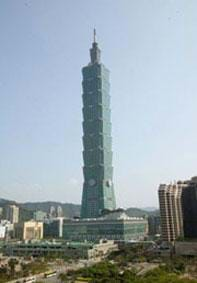
Engineers are constantly being challenged to solve the world's new and complicated problems. Many of these problems initially seem impossible to solve, but engineers find a way to make things happen! In the 20th century, engineers developed previously unimaginable things such as electricity, mass transportation, thousands of different automobiles, and even space travel. Engineers often look back in history to learn from past engineering successes and failures as they design and build amazing new things. Every day, engineers are thinking of ways to improve on what already exists as well as developing brand new ideas that have never been created before. In 2003, the tallest building in the world, the Taipei 101, was completed (see Figure 1). Located in Taiwan, the Taipei 101—named for its 101 floors—stands at 1,671 feet, more than a quarter mile tall! For engineers to come up with a plan for this building (and other similarly challenging structures), they must be creative and think "outside the box."
Let's talk about buildings. What makes a building strong? (If students give answers regarding the materials used [concrete, steel, wood, etc.], continue to ask questions leading them towards the idea of shapes.)] What else, besides the materials used, makes the building strong? Let's brainstorm some ideas. Consider the pyramids in Egypt. Those buildings are very strong and have lasted hundreds of years. They have a very distinctive shape that aids in their strength. Structures must be able to remain standing despite large amounts of force put on them by weight and other factors such as earthquakes or wind. Using different geometric shapes, structures are supported in different ways.
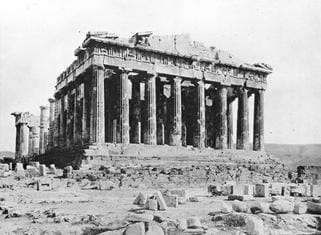
An example of a building using two different shapes, triangles and columns, is the Parthenon, a very successful engineering feat. The Parthenon began construction over two thousand years ago in 447 BC—at the height of the Athenian empire—and is still standing today (see Figure 2). The Parthenon was a temple built to represent the power and strength of the residents of Athens, Greece. This is an excellent example of a well-built structure that engineers can study, enabling them to learn better designs from the past for the future.
Now that we've brainstormed for a little while, let's begin our activity. Today you all are going to be engineers with a specific problem: you must build a structure to hold up as many books as possible using only the materials provided. To solve this problem, think like an engineer. As you work with your team, follow the engineering design process—be creative and think "outside of the box." Remember to keep in mind other things that make buildings strong, besides the materials. And, do not be deceived by using paper and straws to build a structure; paper is very strong when used to its best advantage! (Hint: think shapes; see Figure 3.)
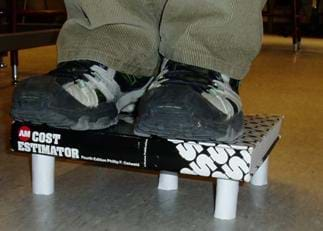
Procedure
Before the Activity
- Gather materials.
- Collect hard cover books for testing. Weigh each book (if they are different sizes) so that students can calculate how much weight their structures support.
- Make either overhead transparencies or handouts of the Design Process Overhead and Brainstorming Guidelines.
- Make the square and triangle shapes using tongue depressors or Popsicle sticks and brads, as shown in Figure 2.

- Draw a table on the board similar to the one below:

With the Students
- Explain the design process to students and show them the design process handout/transparency. Have students define the problem and ask questions about what they need to know to answer the problem. Explain the importance of brainstorming and the suggested guidelines.
Rule 1: Postpone and withhold your judgment of ideas.
Rule 2: Encourage wild and exaggerated ideas.
Rule 3: Quantity of ideas counts at this stage—not quality.
Rule 4: Build on the ideas put forward by others.
Rule 5: Every person and every idea has equal worth.
- Direct students to use the materials to build structures able to hold a book 1.5"-2" off the ground. Explain that they get 1 minute to decide how to build the structures, 8 minutes to build and then 2 minutes to test, so be ready to work quickly.
- Divide the class into groups of three students each.
- Give each team 10 pieces of paper, 10 straws, 1 roll of masking tape and 10 paper clips.
- Begin timing 1 minute for students to discuss their ideas—remind them that this is the time to use their brainstorming skills.
- When time is up, tell them to begin building. Time 8 minutes for students to build.
- After 8 minutes, stop them and begin testing for 2 minutes. Have students calculate the total weight their structures supported (based on the weight of the pre-weighed books they were able to support before the structures failed).
- Have the students record how much weight their structures supported in the table on the classroom board.
- After the first test, ask students if they were successful. (It is unlikely that students find a solution after the first try.) Review with students what they tried, what worked and what did not work. Ask the class what they think engineers do when they are having a hard time solving a problem. (Lead them towards the ideas of using their knowledge of math and science as well as looking at what has worked in the past.)
- Have students think about different geometric shapes and brainstorm which are the strongest.
- Show students prepared shapes made from tongue depressors and brads. Show them how a square deforms under pressure whereas a triangle does not. Show them that by reinforcing a square or rectangle with a diagonal support (making 2 triangles) the new shape is much stronger.
- Encourage students to try building columns and triangles. Explain that triangles are the strongest shape and can be found in most structures. Brainstorm as a class how to make the structures they are building stronger using their new knowledge of the strength of shapes.
- Give students a second try at re-designing and re-building their structures with their existing materials. Again, provide 1 minute to discuss ideas, 8 minutes to build, and 2 minutes to test.
- Ask students if their structures worked this time. What did they do differently? How did looking to past engineering projects help them?
- Have students record the number of books their structures held in the second trial on the classroom board table.
- Ask students to share their design ideas with the class. As a class, discuss how learning from history and knowing more about the strength of shapes helped them build improved structures the second time.
Assessment
Pre-Activity Assessment
Discussion Questions: Solicit, integrate and summarize student responses.
- Why would an engineer want to learn about history? What could an engineer learn from history that would help them create a good design? (Answer: Engineers study history to learn about past engineering successes and failures, which helps give them ideas of things to try and/or avoid in their new designs.)
- Why is brainstorming important? (Answer: It helps us gather ideas from everyone in the team, allowing the team to come up with creative ideas.)
Activity Embedded Assessment
Design Process: Before the re-design, ask the students to write out the design process for their designs. What is the need? How is the problem defined? If the students are having trouble, do the first few steps with the whole class.
Re-Design Practice: Have the students list any design or fabrication changes they would make to the structures. Have them consider buildings and structures they see in their everyday life. Are there any similar characteristics shared by the different buildings? (Encourage the students to think about triangles and pillars/columns.)
Post-Activity Assessment
Presentation: Have the students give a short 1-2 minute presentation about their design to the class. In the presentation, ask them to explain some of the cool features of their projects and show which shapes they used to make their structure strong. Have them tell the class how many books their structures were able to hold and describe the failure mode of their designs. (Figure 5 shows the three types of failure modes. Most structures fail by buckling and a few by compression.) Have them give a few ideas of how they could make their structure even stronger (i.e., by adding more columns, thicker columns or triangles).
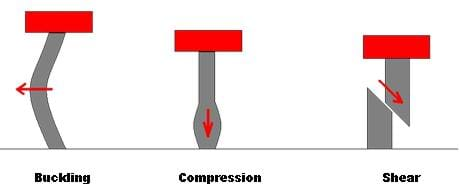
Discussion: Talk as a class about some of the ideas that could be used to make the structures stronger. Show some pictures of buildings that utilize the different (and strong) shapes. If you are doing this as part of the Introduction to Engineering unit on the Olympics, show examples from Athens, Turin, Beijing and other Olympic cities to keep with the theme. A great U.S. example is the D.C. capitol building that uses pillars, triangles, arches and domes! As each group presents, a list compiled a list of their ideas, which the class may review once the presentations are finished.
Safety Issues
Use caution when cutting straws with scissors.
Troubleshooting Tips
If doing this activity as part of the Olympic Engineering unit, gear your examples towards the Olympics by showing pictures from Olympic sites and cities.
If part of a structure is carrying more weight than the rest, the structure will most likely fail faster and not be able to hold as much as when the structure is loaded evenly. Point out that how the structure is loaded with weight plays an important role in its success or failure.
If students get frustrated during the first attempt, shorten the building time.
If students do not find success on the second attempt, encourage them to learn from the design models of other successful groups. Ensure that they understand the relevance of different shapes and their strengths. If time allows, give the group the opportunity to build one last design after they understand the concepts.
Activity Extensions
Have students calculate how much taller the Taipei 101 tower is than their school building. (Answer: The average classroom is about 15 feet tall. 1671/15 = 111.4 times taller.) Then figure out how many fourth-grade students it would take standing on each other's shoulders to reach the top of the Taipei 101 Tower. (Answer: Take the average height of the class and divide into 1671 to see how many students it would take to reach 1,671 feet tall.)
Have the students think of other shapes that appear in structures. What about arches and domes? Or more simple shapes like octagons and hexagons? Which shape do they think is the strongest? Have the students build and test their own shapes.
Have the students research structural engineers and create a list of five projects they might have worked on.
Activity Scaling
- For younger students, give them more time to brainstorm and build.
- For older students, reduce the time to build and have them make a longer, more in-depth presentation.
- For more advanced students, challenge them to make a structure that can support a student standing on a textbook (see Figure 3). Have a class competition to see which team can create a structure that holds the most weight.
Subscribe
Get the inside scoop on all things TeachEngineering such as new site features, curriculum updates, video releases, and more by signing up for our newsletter!More Curriculum Like This

The Olympics are introduced as the unit theme by describing the engineering required to build grand and complex event centers. Then students are introduced to the techniques of engineering problem solving, specifically brainstorming and the steps of the engineering design process.

Students learn about the history of the world's tallest free standing structures and the basic design principles behind their success. They build their own newspaper skyscrapers with limited materials and time, trying to achieve a maximum height and the ability to withstand a "hurricane wind" force...
References
Taipei 101, Understanding Health Cities. 2005 Taipei City Government. Accessed October 17, 2006. english.taipei.gov.tw/MP_100002.html
Copyright
© 2006 by Regents of the University of Colorado.Contributors
Tod Sullivan; Melissa Straten; Katherine Beggs; Denali Lander; Abigail Watrous; Janet YowellSupporting Program
Integrated Teaching and Learning Program and Laboratory, University of Colorado BoulderAcknowledgements
This digital library curriculum was developed under grants from the Fund for the Improvement of Postsecondary Education (FIPSE), U.S. Department of Education, and National Science Foundation (GK-12 grant no. 0338326). However, these contents do not necessarily represent the policies of the Department of Education or National Science Foundation, and you should not assume endorsement by the federal government.
Last modified: July 27, 2023






User Comments & Tips